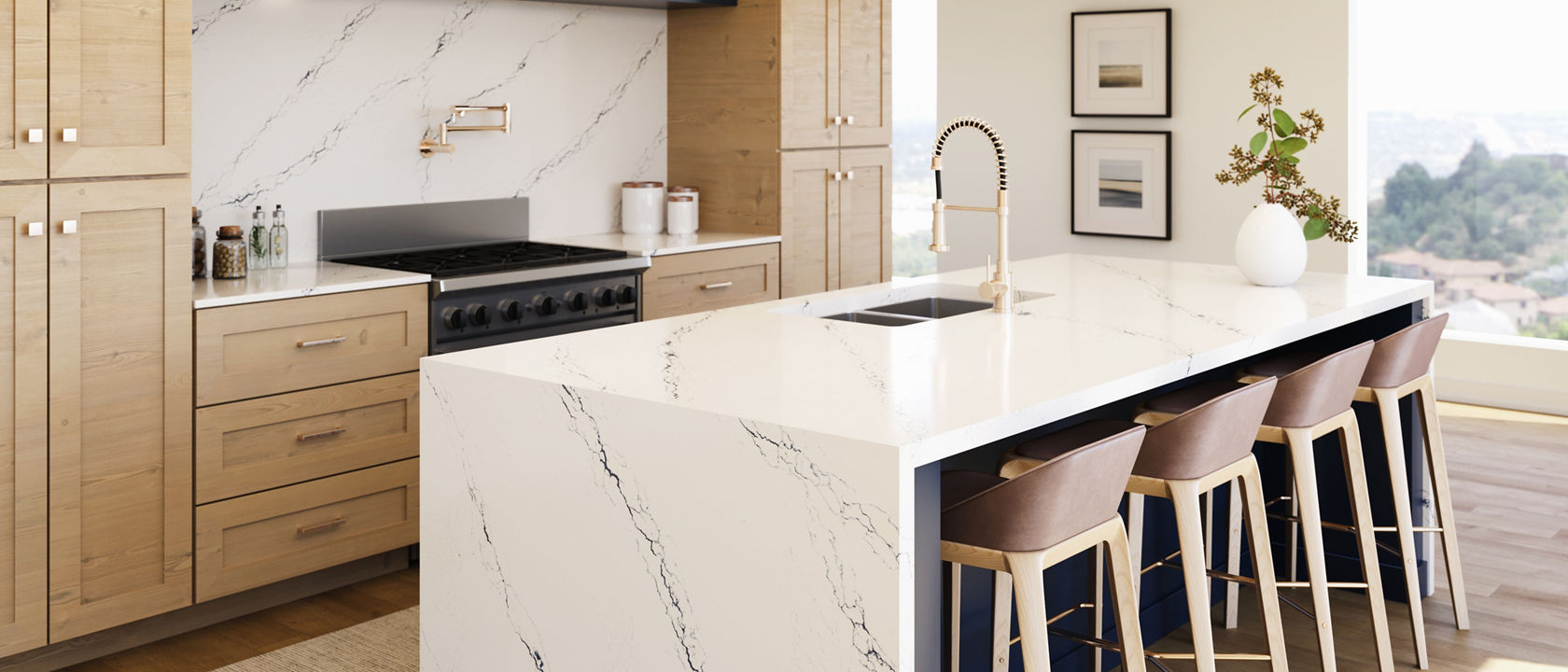Determining if a kitchen island layout suits your needs when planning your renovation is a crucial step in the planning process. As kitchens have become the hub of the home, home cooks, frequent entertainers, and dynamic families all appreciate the benefits of a kitchen island layout for different purposes. Beyond that, it’s important to evaluate available space, traffic patterns, and storage needs when deciding on the best kitchen layout.
A typical kitchen island layout includes at least one perimeter wall of counter space for storage and major appliances. The kitchen island adds additional prep space, storage, and in many cases, seating.
You’ll need to decide whether your kitchen island should incorporate your main sink or an extra prep sink. These decisions often involve redirecting plumbing, which can be a major renovation expense. Consider your budget and how long you plan to remain in the home. This option could absolutely be worth it for the sake of functionality and enjoyment.
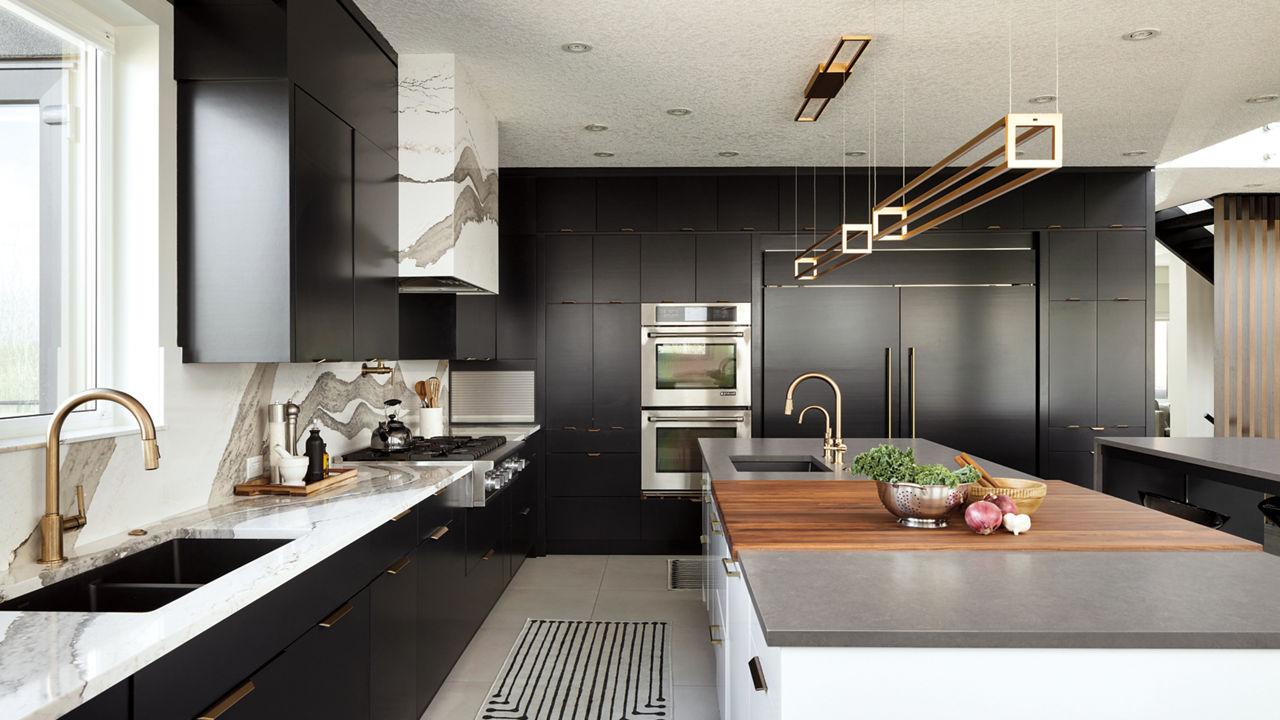
Cambria designs shown: Skara Brae™ and Carrick™ Photo by Eymeric Widling
Should Your Kitchen Island Have a Sink or Stove?
There are several important things to consider when deciding whether your sink should be on the kitchen island: If you enjoy the view out your kitchen window or watching your kids play in the yard while working at the sink, then a kitchen island sink as your main sink is probably not for you. But if you find delight in engaging with family and guests who are seated at your kitchen island while you rinse vegetables or wash dishes, then working a sink into your island layout is worth considering.
Also, does having your dishwasher (which is typically plumbed no more than 4–6 feet from the sink) incorporated into the kitchen island make it easier to put clean dishes away? Then again, do you cook frequently and love experimenting with recipes that require lots of cookware?
Heavy use can be a downside to having your sink located on the kitchen island. Although Cambria quartz countertops ensure spills don’t become stains, you may not want piles of dirty pots and pans to become an ongoing eyesore. Deep sinks and/or diligent type A personalities who can’t sleep without cleaning up can also help in this area.
And what about that cooktop? Locating it on the kitchen island can make cooking a more sociable event and free up perimeter counter space. But the potential for hot food spatter—again not a problem when it comes to cleanup on Cambria quartz surfaces—can be a bit risky for the folks seated across from the cook.
Also, be sure to think through ventilation options for any cooktop or range you plan to locate in/on the island. A high ceiling in the kitchen may require a downdraft or pop-up vent. But don’t rule out creating a stunner of a showpiece range hood over your cooktop or range located along the perimeter of the space and let your beautiful island countertops be free of competing focal elements.
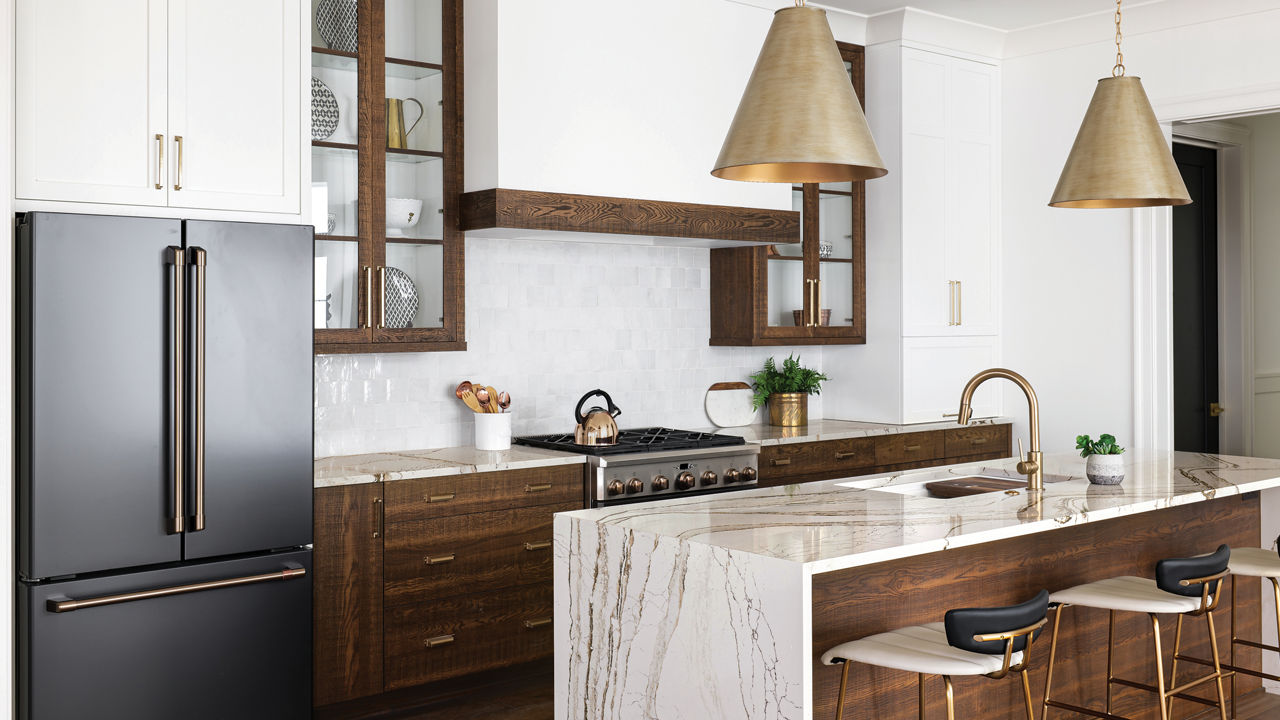
Cambria design shown: Clovelly™ Photo by Tim Furlong
How to Plan for Kitchen Island Traffic Patterns
A kitchen layout rule of thumb is to plan easy navigation between sink, stove, and refrigerator—or the three main workstations—in a triangle pattern with a sum distance of all three triangle legs totaling no more than 25–30 feet. No leg of your kitchen triangle should “cut through” the kitchen island. You just don’t want to add unnecessary steps every time you need to grab something from the refrigerator. Now, if your kitchen designer chooses to ignore this rule as passé, make sure any alternate layout works well with how you plan to work within your space.
Also, make sure you have the right amount of space for flow. Three feet is the suggested minimum distance between your perimeter counter and kitchen island but that can feel tight when two or more people start moving around in there. Aim for a minimum of 40 inches where possible. And if you’re also planning to include kitchen island seating, be sure there is enough clearance for people to get in, out, and around their seats.
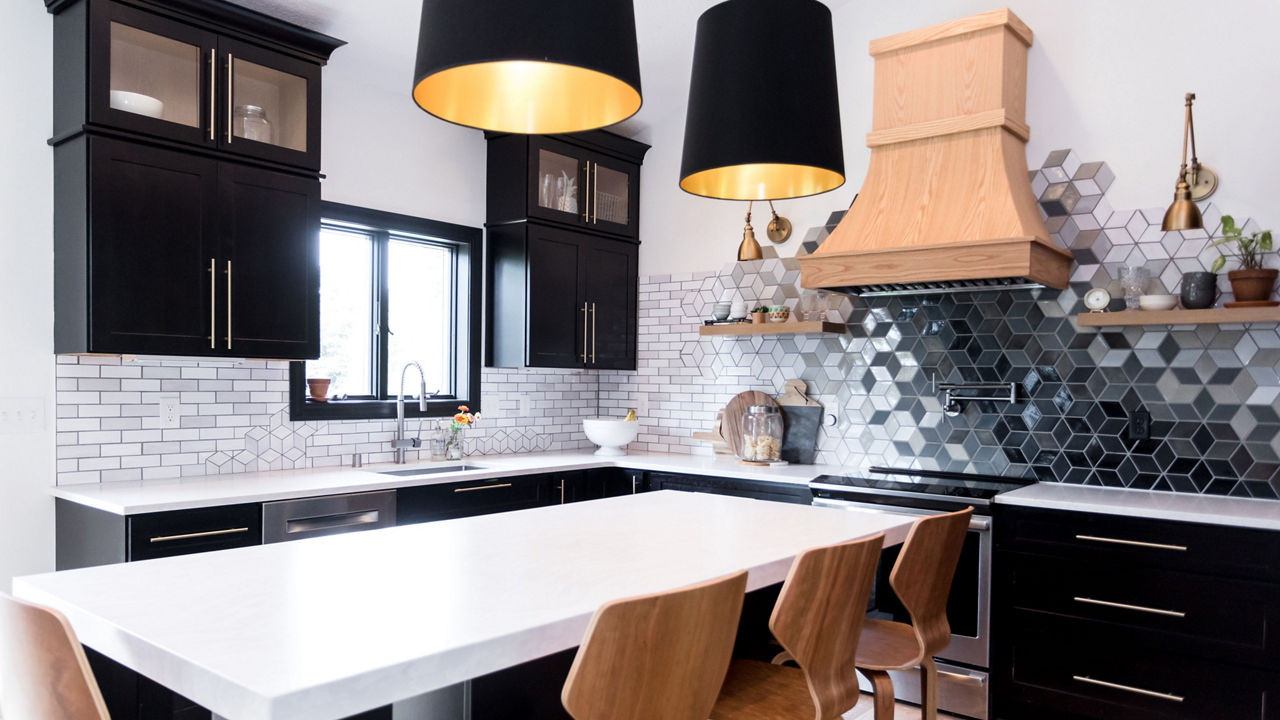
Cambria design shown: Delgatie™ Photo by Chelsie Lopez
Incorporating Seating at Your Kitchen Island
When it comes to seating, the perimeter of space available around each potential seat will help you determine the number of seats for people to comfortably get in, out, and around. But before you start the journey of shopping for your favorite furnishings, be sure you’ve worked out how high your kitchen island counter will be and the depth of clearance you will have for sliding stools underneath the countertop overhang.
Bar Stools vs. Counter Stools
The standard height for kitchen countertops is 36 inches. So, if you’re planning one standard height across your kitchen island, you’ll want to find counter-height stools with seat heights of around 24–27 inches from the floor. Counter-height stools are 4–6 inches shorter than bar stool heights which can have seats up to 30 inches high. So pay attention when shopping. You certainly don’t want to invest in seating that is either too tall or too short to comfortably accommodate dining, visiting, or doing homework.
Two-Tiered Kitchen Islands
There was once a trend of two-tiered kitchen island counters that have prep space on one side and a higher bar countertop on the opposite side. This shields some of the mess of cooking in an open-concept space, but it limits your flexibility with both prep and dining spaces made shallower. If this is your preference, be sure to seek taller bar stool–height seating for the higher bar counter portion.
A more recent trend is kitchen islands that incorporate a lower, table-height area. If you’re leaning in this direction, seek out seating you love that is meant for a standard table height or stools with that much lower seat height of around 18 inches.
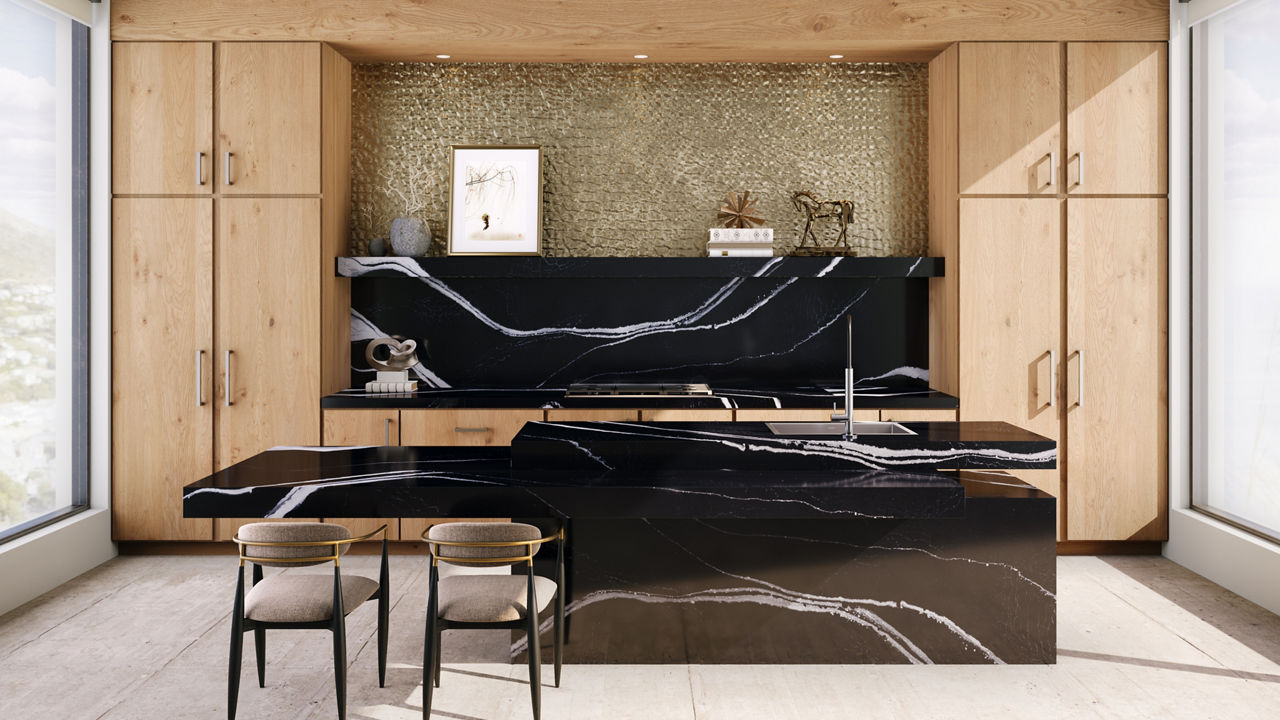
Cambria design shown: Mersey™
Practical Seating Considerations
Practicality can also play a role when choosing seating. Do you have young children who might spill or smear their Cheeto-stained fingers on your designer fabric upholstered counter stools? If that’s the case, look for seating made with materials that cause less stress—like wood, metal, vinyl, etc. Swivel stools can also be a distraction or even a hazard for little kids. Contrast that with what will make you and your adult guests most comfortable while seated. Your visiting parents will surely appreciate padded seats that also have some sort of back support.
Only you can decide which type of seating fits your design style and complements your overall kitchen renovation. And if your tastes lean toward more chair-like counter stools, be sure your kitchen island countertop has sufficient overhang to allow the seats to slide partly or fully under the counter and out of your traffic pattern.
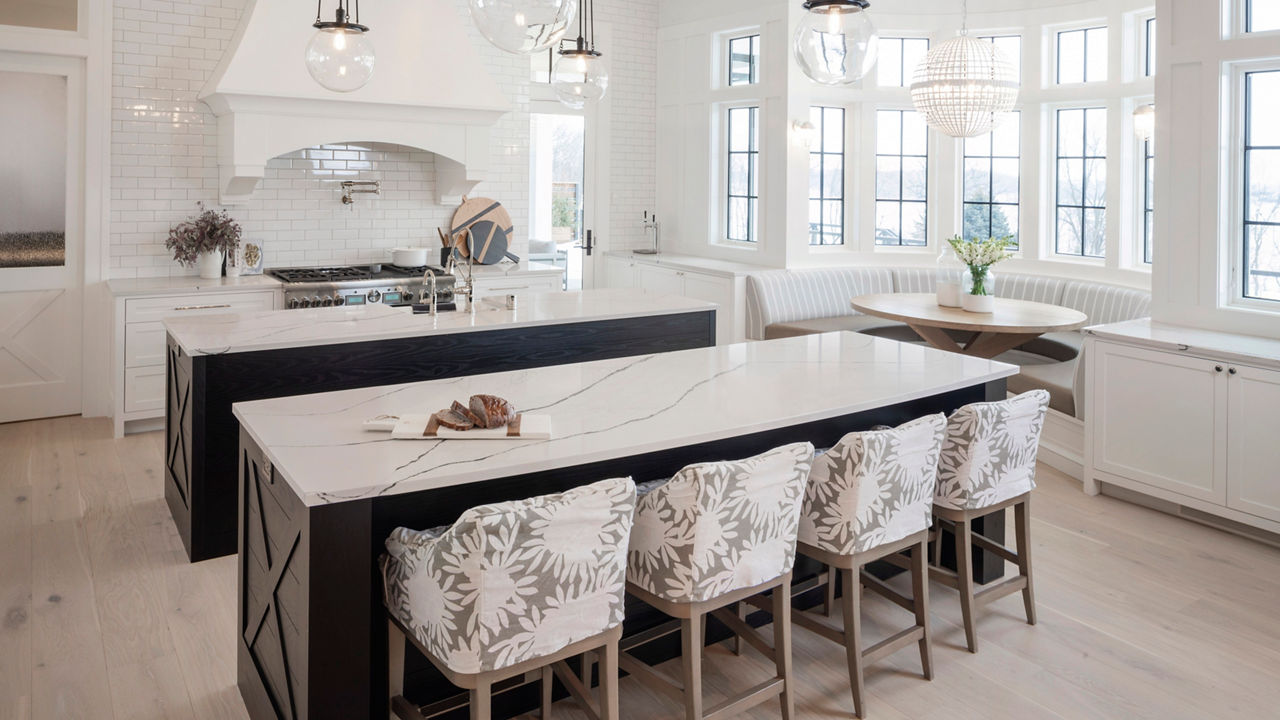
Cambria design shown: Gladstone™
Double Kitchen Islands
If you have a lot of kitchen space or desire an even more open-concept floor plan, a double-island layout might be a good solution for your kitchen renovation plan. This option will maximize storage space and separate your food prep area from your seating area. Double islands also give entertainers more flexibility when hosting guests. Envision having enough room to set up those elaborate holiday buffets or bookclub charcuterie parties with plenty of space to mix and mingle.
Want more design ideas? Download our complimentary Kitchen & Bath Design Inspiration Planner—a handy reference tool filled with strategic tips, expert advice, and an abundance of inspiration.
[Updated on 12/05/2023]
Discover More
Get our beautifully curated collection of lifestyle stories, interior design trends, and expert advice sent straight to your home and email inbox with a complimentary subscription to Cambria Style magazine.
Ready to explore Cambria quartz designs in person? Contact a Cambria consultant or use our retail locator to find a professional in your area for project support and planning, material selection, or visualizing what’s possible.
Explore the #MyCambria Gallery to see how others transformed their spaces and follow us on social media.
Get the Look
Explore the designs featured in this story.

